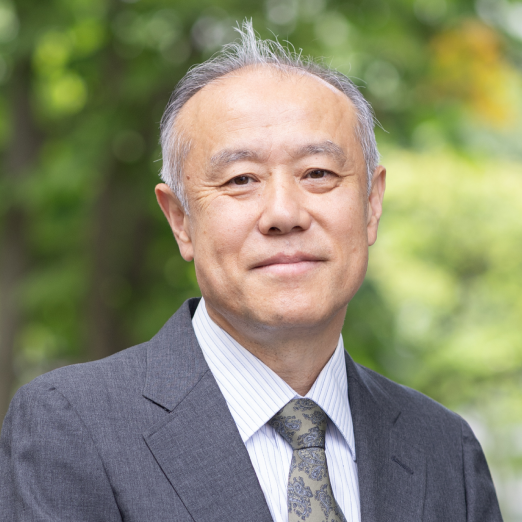
長谷川 剛 教授
HASEGAWA TSUYOSHI
専門分野
AIエレクトロニクス
マテリアル知能を使ってSDGsな情報処理を実現しよう
研究テーマ
イオン伝導体を用いた脳型素子開発 / 物理リザバー / 表面・界面で起こる物理化学現象の探索とその原理解明
キーワード
イオン伝導体,脳型素子,物理リザバー,表面界面
LINKS
RESEARCH OVERVIEW
研究概要
物質内で起こる様々な物理化学現象を利用すると、現在はソフトウエア上で動作している人工知能(AI)も、より小型で高性能、かつ低消費電力で動作するようになります。長谷川研究室では、自分で賢くなる脳型コンピューターの開発を目指して、イオンの移動とその酸化還元反応を利用した脳型デバイス並びに脳型情報処理システムの研究開発を行っています。
例えば、私たちの脳は、短期記憶と長期記憶という2つの記憶モードを使って、重要な情報を選別して記憶しています。この動作を、私たちは、イオンの拡散と酸化還元反応を用いて再現してきました。イオンの拡散は低電圧でも誘起できますが、電圧印加を止めるとイオンは元の位置に戻って行ってしまうので短期記憶の模倣に、酸化還元反応はイオン濃度を高めないと起こりませんが、簡単には元の状態には戻らないので長期記憶の模倣に使えると言うわけです。
現在のコンピューターでは、情報処理と記憶を異なる素子が担っています。これに対して、私たちの脳では、情報処理と記憶を一体となって行うネットワーク型の情報処理が行われています。現在流行りの深層学習もネットワーク型の情報処理システムですが、これを計算機を用いずに物質・材料だけで行ってしまおうというのが、物理リザバー計算です。長谷川研でも、基本動作の実証に始まり、物体や画像の認識、ジャンケン判定システムの開発などを行ってきました。
上記のほか、表面や界面で起こる様々な物理・化学現象の観測、そのメカニズム解明などの基礎研究も行っています。研究には遊び心も大切です。原子操作によって描いた文字は、今でも世界最小の文字です。そのときに得られた経験や知見が、原子移動型素子(原子スイッチ)の発明に繋がり、マテリアル知能を活かした現在のAI開発研究にも繋がっています。
MESSAGE to STUDENTS
学生へのメッセージ
研究とはブラックボックスを一つずつ無くしていく地道な作業です。その先に、新たな発見や感動があります。山登りや探検と同じで、用意周到な準備も欠かせません。研究の世界で言えば、何事も理解しながら進めることが大切です。人工知能(AI)が急速に普及する現在、皆さんにはAIを超える想像力が求められています。千里の道も一歩から。興味のある分野から勉強を始めて、将来の飛躍に繋げて下さい。
学歴・経歴
1985年 東京工業大学 理学部 卒業
1987年 東京工業大学大学院総合理工学研究科 修士課程修了
1996年 博士(理学)東京工業大学
1987年 (株)日立製作所中央研究所
1998年 同研究所 主任研究員
1999年 (特)理化学研究所 先任研究員
2002年 (独)物質・材料研究機構 主幹研究員
2003年 同機構 グループリーダー
2007年 同機構 国際ナノアーキテクトにクス研究拠点 主任研究者(グループリーダーを兼務)
2011年 同機構 原子エレクトロニクスユニット ユニット長(兼務)
2015年 早稲田大学 理工学術院 教授
所属学協会
- 日本物理学会
- 応用物理学会
- 日本表面真空学会

HASEGAWA TSUYOSHI
Professor
Field of study
AI electronics
Let’s use intellinegence of materials for new AI systems
Research Themes
Neuromorphic devices made of solid electrolytes / Physical reservoir computing / Physicl and chemical phenomena at surface and interface
Keywords
Ionic conductor / Neuromorphic device / Physical reservoir / Surface and interface
RESEARCH OVERVIEW
By utilizing the various physical and chemical phenomena that occur in materials, artificial intelligence (AI), which is currently based on software, can be made smaller, more powerful, and consume less power. We are developing neuromorphic devices and systems utilizing the movement of ions and their redox reactions, with the aim of developing brain-type computers that can learn by themselves and become smarter.
For example, our brains use two memory modes, short-term memory and long-term memory, to select and store important information. We have succeeded in mimicking this behavior using ions’ diffusion and their redox reactions. Although ions’ diffusion can be induced even with low voltages, ions start to move back to their original position when removing the bias application. This phenomenon can be used to imitate the short-term memory. On the other hand, increase in the ions’ concentration is needed to cause Redox reactions. But once it occurs, the state is kept stable, which can be used for the long-term memory.
In current computers, information processing and memorization are achieved by different elements that are separately placed. In contrast, in our brain, they are performed together in a network-type system. Deep learning, the current popular AI system, is also based on the network system. Physical reservoir computing is a new concept that enables computation only using materials without present-day computers. It is our major research target, where we have demonstrated basic operations as well as recognition task of images and objects and rock-paper-scissors judgment.
We also conduct basic researches such as observing various physical and chemical phenomena that occur on surfaces and interfaces, and revealing their mechanisms. A sense of playfulness is also important in research. The letters drawn by atom manipulation are still the smallest letters in the world. The experience and knowledge gained at that time led to the invention of the atomic switch, which is also led to the current AI system development that utilizes material intelligence.
MESSAGE to STUDENTS
Research is the steady work of removing black boxes one by one. Beyond that you can have new discoveries and excitement, which is just like mountain climbing or exploring. Therefore, careful preparation is essential. It is also important to proceed with understanding everything. The rapid spread of artificial intelligence (AI) requires you to have original ideas beyond that AI has. A journey of a thousand miles begins with a single step. Please start your study in the field that interests you to make a leap in the future.
Education and Career
“1985: Graduated from the Faculty of Science, Tokyo Institute of Technology
1987: Completed a Master’s degree at the Graduate School of Science and Engineering, Tokyo Institute of Technology
1996: Ph. D(Science), Tokyo Institute of Technology
1987: Researcher, Hitachi Central Research Laboratory
1998: Senior Researcher, Hitachi Central Research Laboratory
1999: Senior Researcher, RIKEN
2002: Principal Researcher, National Institute for Materials Science(NIMS)
2003: Group Leader, NIMS
2007: Principal Investigator (concurrently Group Leader), WPI Center for Materials Nanoarchitectonics (MANA), NIMS
2011: Unit Director (concurrently), Atomic Electronics Unit, MANA, NIMS
2015: Professor, Faculty of Science and Engineering, Waseda University”
Professional Memberships
- The Physical Society of Japan
- The Japan Society of Applied Physics
- The Japan Society of Vacuum and Surface Sciences
